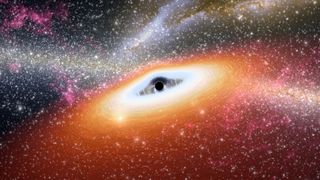
An illustration of a primitive black hole forming.
(Image credit: NASA/JPL-Caltech)
Astronomers have figured out how some dying stars kick baby black holes out of the womb — and it’s not pretty.
These rare black holes get a significant kick when their parent stars die in a cataclysmic explosion, rocketing the newborn gravitational gluttons out at incredible speeds, a new study found.
The findings could shed light on the enigmatic first moments of a black hole’s life.
Black holes and neutron stars are born in the hearts of massive, dying stars. When stars with at least eight times the mass of the sun near the ends of their lives, they fuse iron in their cores. Intense pressures turn that iron core into a proto-neutron star, a clump of neutrons about the size of a city. That clump can temporarily halt the gravitational collapse of the rest of the star. In turn, this stall-out usually triggers a supernova explosion. But pressures can sometimes rise in the hearts of those explosions, smashing that proto-neutron star down into a black hole.
What happens next is anyone’s guess. Previous computer models of supernovas simulated only less than a second of that process — just enough to capture the explosion itself. And observations of real black holes and neutron stars suggest all sorts of funky physics. Some neutron stars move at over 3.4 million mph (5.4 million km/h), indicating that they got violently kicked out during the explosion process, while others move 30 times slower, suggesting a more serene birth process.
Black holes, on the other hand, almost always have low “kick” velocities, even though the circumstances of their creation are much more violent.
Related: James Webb telescope discovers oldest black hole in the universe
A team of astronomers elucidated the awkward newborn period of black holes and neutron stars by running 20 computer simulations of supernovas. The simulations ran long enough to show how each object was “kicked” by its parent star. Their work was published to the preprint database arXiv Nov. 20 and has been submitted to The Astrophysical Journal for peer review.
The astronomers discovered a tight relationship between the properties of the parent star prior to the explosion (known as the “progenitor”) and the resulting neutron star or black hole. When the parent star isn’t very massive and isn’t very compact — meaning its outer layers are enlarged relative to its core — the supernova happens very suddenly and in nearly a perfect sphere, leading to a slow-moving neutron star.
On the other hand, very massive, compact progenitors take longer to go supernova, and when the explosions occur, they’re not very symmetrical. This produces a fast-moving, kicked neutron star emerging out of the chaos. The researchers also found that larger neutron stars tend to get kicked harder, meaning that more of a compact progenitor’s mass in the core winds up in a neutron star.
Progenitors also send neutron stars spinning, and the researchers found that, generally, the greater the kick, the greater the spin. So if the progenitor star exploded asymmetrically, then the irregular explosion not only pushes out the neutron star but also spins it up. This may explain the origins of magnetars, which are rapidly spinning, supermagnetized neutron stars.
Two formation mechanisms explain how black holes get kicked. In one case, the progenitor doesn’t fully explode, but the pressure on the core ramps up to the point that a black hole forms. These black holes are rather large — roughly 10 solar masses, on average — and barely get kicked. Most black holes fall into this category.
But black holes can also form via a second pathway. In some cases, the progenitor star fully explodes and carries off a lot of mass, leaving behind a smaller black hole of roughly three solar masses. Interestingly, these black holes receive incredible kick velocities, greater than 2.2 million mph (3.6 million km/h), the study found. These fast-moving black holes are quite rare, though.
The research makes an important connection between what we can observe (neutron stars and black holes moving around the universe) and what we can’t (namely, the details of the progenitor explosion process itself). By surveying the properties of neutron stars and black holes, astronomers will be able to work toward painting a complete picture of the stellar life cycle.
Get the world’s most fascinating discoveries delivered straight to your inbox.
Paul M. Sutter is a research professor in astrophysics at SUNY Stony Brook University and the Flatiron Institute in New York City. He regularly appears on TV and podcasts, including “Ask a Spaceman.” He is the author of two books, “Your Place in the Universe” and “How to Die in Space,” and is a regular contributor to Space.com, Live Science, and more. Paul received his PhD in Physics from the University of Illinois at Urbana-Champaign in 2011, and spent three years at the Paris Institute of Astrophysics, followed by a research fellowship in Trieste, Italy.
>>> Read full article>>>
Copyright for syndicated content belongs to the linked Source : Live Science – https://www.livescience.com/space/black-holes/turbulent-1st-moments-of-a-black-holes-life-captured-in-new-simulations































